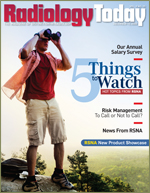
December 15, 2008
Comparing MRI With Mammography
By Kathy Hardy
Radiology Today
Vol. 9 No. 25 P. 30
Oncology surgeons and radiologists in Michigan are looking at past and current data to conduct a comparative analysis of MRI vs. mammography in the evaluation of lesion size, number of lesions, and nodal status in patients with breast cancer. To date, the study shows that MRI continues to appear more sensitive than mammography for finding lesions, an important factor in early breast cancer detection. However, study results also highlight that MRI tends to overestimate lesion size when compared with pathology findings.
Work began with a retrospective study performed on data from 195 breast cancer patients undergoing MRI and mammography at two Michigan medical facilities. In this phase of the study, tumor size was reported in 184 lesions by MRI and 113 lesions by mammogram. When considering the stages of lesions detected by MRI and mammography, 35% were T1, 39% were T2, 13% were T3, 4% were T4, and 9% were in situ.
Looking at lesions detected by separate modalities, 9% of the MRI-detected lesions were exactly the same size, 65% were overestimated in size by a mean of 1.04 centimeters, and 26% were underestimated by a mean of 0.65 centimeters. For lesions found with mammography, 11% were the same size, 37% were overestimated by a mean of 0.81 centimeters, and 52% were underestimated by a mean of 0.74 centimeters.
On the issue of the number of lesions found, 36 of the 184 MRI-detected lesions were additional malignancies identified in 29 patients. In addition, eight lesions were found in the opposite breast.
According to Sukamal Saha, MD, a surgical oncologist at McLaren Regional Medical Center in Flint, Mich., the number of study participants increased to more than 250 patients, with 263 lesions discovered to date.
“Overall, in people with head-to-head comparisons between mammography and MRI, in approximately 15% of the cases, we found shadows with MRI that were proven to be cancer but were missed by mammography,” Saha says. “In addition, in 5% of the patients, we found cancer in the opposite breast. In 20% of the patients, MRI changed my plan for operating. There were more surgeries involved than I had originally considered due to the MRI findings.”
Saha notes that the identification of additional lesions found with MRI further supports the utility of MRI over mammography in the management of early breast cancer. “MRI is more accurate in finding lesions,” he says.
The other important factor in this study is the size of the lesions. Results show that in the majority of patients, MRI overestimated the size of tumors, while mammography underestimated tumor size.
In this study, Saha uses the example of a lesion that was shown through pathology to be 1 centimeter in size. MRI overestimated the size of that lesion to 1.119 centimeters, and mammography underestimated the lesion’s size as 0.6 centimeters.
“As size goes up, we found lesions to be an average of 0.66 centimeters larger with MRI,” Saha says. “The contrast dye shows lesions larger than with mammography.”
Size plays a significant role in determining T-stage classification and can be an important factor, particularly for T1 and T2 lesions, Saha says. He notes that as more physicians look to begin chemotherapy treatments up front, more accurate lesion measurements are vital to determining dosages.
“If MRI says a patient has a 2-centimeter lesion, the patient may undergo surgery prior to chemotherapy,” he says. “However, if the lesion turns out to be [closer to] 3 centimeters in size, we should have treated the patient with chemotherapy first.”
Saha says the process of studying MRI vs. mammography results is ongoing. His work stems from patients undergoing treatment from 2002 to the present and will continue into 2009. With seven years of data, he believes researchers can come closer to an answer regarding the benefits of MRI in breast cancer detection and treatment.
“We’re finding that some day, we’ll know the real value of MRI,” he says. “When lesions are missed, patients die. We know that using MRI changes treatment, but does it save lives? Time will tell. We need to see if the survival rate is better when MRI is done.”
The next area of study for MRI screening is in the lymph nodes. Saha says current statistics show that MRI is not the best method for finding cancer in the lymph nodes surrounding the breast. Biopsy is considered the gold standard for determining whether cancer has spread, but with that comes the risk of surgery and the possibility that the sampled section does not represent the entire node, and lesions could be missed. Also, chemotherapy performed prior to biopsy can mask where cancer existed in the lymph nodes. However, developments in MRI have improved to the point where physiological information found on the MRI could show the likelihood of lymphatic lesions.
“The evolution of the lymph node study is coming,” Saha says. “The better we get with MRI, the more likely we will find lesions in that area.”
— Kathy Hardy is a freelance writer based in Phoenixville, Pa., and a frequent contributor to Radiology Today.
